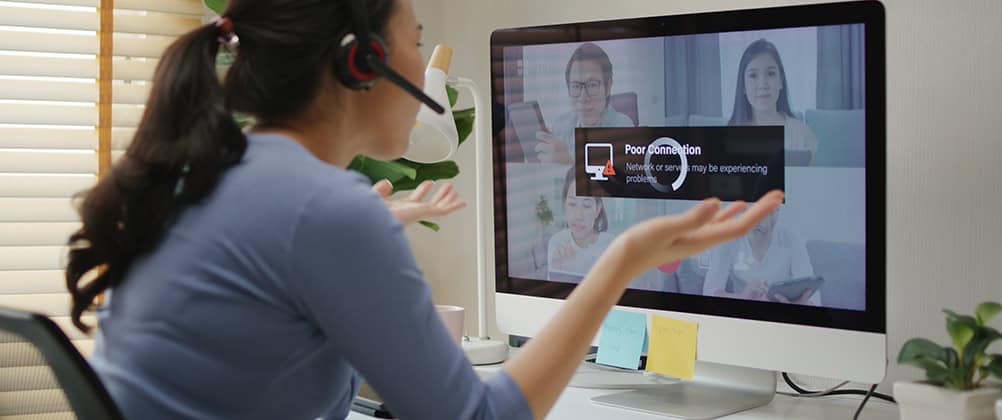How Can You Enhance Workforce Quality in Remote Work Settings?

Organizations are trying to preserve an innovative hybrid work model. Collaborating with futuristic tech tools like Learning Management Systems [LMS] is the first step to creating a creative and engaging work environment. However, research suggests a ‘large gap’ in the execution of hybrid work technologies in companies. So let’s discuss on the topic Workforce Quality In Remote Work Settings.
How can companies overcome this gap? How can LMS solutions help your company get there? Here is what we think…
The basic purpose of an LMS is to assist your employees in acquiring new skills at any time, anywhere and from any device.
An LMS facilitates the creation and remote distribution of your company-specific course content. LMS also simplifies employee onboarding and helps analyze learner data while building a strong employee-employer relationship. What you get in return will be a workforce constantly acquiring new skills additionally boosting employee engagement and retention.
Read more: Powering Corporate Training with SCORM Compliant Learning Management System
Importance of Ensuring Workforce Engagement in Remote Work Environment
Are the remote and hybrid work models changing how your workforce collaborates and engages?
Your workforce efficiency largely depends on the ease of collaboration and engagement. When employees engage better, they are well-equipped with knowledge, skills, and resources to perform their jobs effectively. Although remote and hybrid models have jilted traditional desk-to-desk conversations, technology is helping maintain effective engagement systems. Here’s why ensuring workforce engagement and motivating them in a remote work environment is essential!
1. Promotes Employee Efficiency and Accountability
Tracking employee capabilities and skill gaps can help better utilize talents for organizational growth. Optimizing the workforce structure will help motivate your employees, encouraging them to acquire more skills. Regular training and ensuring those skills are put to use will make your staff feel valued and in turn strengthen your workforce.
2. Boosts Learning as a Team
Like working should be collaborative, learning should also be collaborative. We say so because your employees are inherently social, and learning as a team can bring them closer and nurture the spirit of collaboration. Learning as a team through team activities can get your employees to experience beyond meetings and lectures. Make your employees solve quizzes and problem-solving questionnaires together.
3. Improves Problem-solving and Spurs Innovation
With a collaborative approach, employees with diverse knowledge and skill sets will be in the mix, which improves competence and experience. When your employees with different skill sets come together, a more creative and efficient way to solve problems will exist. It is not just that! When in a team, there will always be a handful of employees updated with new technologies, which helps maintain the team’s momentum. This will spur innovation, creating a continuous loop of ideation and innovative solutions.
4. Increases Employee Satisfaction
Employee collaboration creates an open work setting where people feel valued and heard. When employees are happy and satisfied, it reflects their contribution to the company’s culture and outcomes. Employee satisfaction is, in fact, one of the driving forces for employees happily going to work, tending to be more accountable and less likely to leave the company.
5. Aligns Remote Teams
We are in the remote and hybrid working era. Your company might even have distributed teams. How can such teams be aligned? Even if yours is a global company with multiple offices spread across the globe a simple learning tool or Employee GPS tracking apps can ensure that all your employees are up-to-date, aligned, and connected through collaboration. We are pointing to your workplace turning into an environment where no employees feel siloed, adversely impacting their productivity and employee retention..
Ways to Engage Employee Engagement and Collaboration
First, evaluate your tech stack and see what is missing in assisting your employees in achieving tasks that promote company culture. Your company’s tech stack indicates whether your workplace has a good communication and collaboration setting at your workplace. Irrespective of whether your company has a good tech stack or a remote, hybrid, or distributed team, we share a few ways to facilitate a collaborative work environment.
1. Streamlined Virtual Onboarding
Onboarding solutions develop the framework for enhanced employee experience right from the beginning. Onboarding backs combining training resources from different departments into a unified platform, thus making it easy for new hires and considerably reducing costs. Onboarding can reduce the redundancy in training materials.
A 2021 Toggl survey revealed that 60% cited onboarding employees remotely as the biggest adjustment to the pandemic. A streamlined virtual onboarding implies that your employees have a grasp of their responsibilities, their colleagues, and the company culture.
Onboarding should give the new hires a good idea of their team members, training agenda, and, most importantly, how much your company values collaboration.
2. Focus on efficiency and accountability
As everyone who’s ever spent three hours spinning their wheels in a meeting room can tell you, spending more time together on a task doesn’t equate to collaborating better.
One way to improve employee collaboration is to stay on top of how much time is spent on each task and how efficiently people work together. Project management software that includes time-tracking capabilities like Hubstaff and Toggl can help.
What can help even more is setting up a time limit for meetings and brainstorming sessions and setting clear deadlines for tasks—and a script about the next steps when an employee struggles with all or parts of the process.
3. Encourage Hybrid and Asynchronous Brainstorming Sessions
Employee collaboration and brainstorming collectively matter a lot for a company’s progress. Such collaborative approaches ensure that all your employees have opportunities to share ideas and raise questions irrespective of where they connect from. Employee collaboration can be further encouraged through asynchronous brainstorming sessions, particularly when you have distributed teams. For instance, your company should have a common platform in place where employees express their ideas and suggestions and where your employees can build on an employee’s input.
4. Train Together, Learn Together
Employee collaboration should be a primary focus whether your team is distributed or remotely working. Team synergy among your workforce can be enhanced when employees train and learn together. It will bring them closer when employees learn together rather than attending scheduled conventional Zoom meetings. Including group activities like quizzes and other gamified learning, approaches can create a positive environment for your team’s problem-solving. Team training is the optimal option if you aim to build a strong team and improve employee collaboration.
Read more: Why Consider LXP over LMS for Employee Training and Development
How a Platform Like Skill Lake Can Help
When you have remote working employees, it is essential that they carry out their routine tasks hassle-free. Employee collaboration is one aspect that your company cannot compromise in such a setting. This is where Skill Lake can help. The key features of Skill Lake are eliminating time and distance barriers and promoting employee collaboration through a unified platform.
Skill Lake LMS can take the wheel in the hybrid work revolution by:
- Boosting learner engagement
- Creating a positive onboarding experience
- Facilitating real-time visibility
- Considerably reducing training time
- Offering flexibility to employees
- Providing easy access to learning content
- Improving employee retention
- Encouraging discussion and debate
- Simplifying assessment process
- Backing competency mapping
- Creating transparent feedback loops
The hybrid work revolution results in a diversified, engaged, and, most importantly, satisfied workforce. Even so, it necessitates refreshed skills and the implementation of digital technologies like Skill Lake. This would make your company pivotal in this brand-new hybrid-first work environment.
Skill Lake aims to increase flexibility and autonomy and make your employees choose positive outcomes over presenteeism. This is one of the reasons why you need to refurbish your tech stack with Skill Lake. While you sit back and focus on your other primary business operations, Skill Lake will support employee collaboration which is primed for these new kinds of operations. Connect with us now!
Build a culture of continuous learning with Skill Lake’s state-of-the-art people development platform. Give your employees professional training to help them excel in their job roles and propel your business to greater efficiency and success.
Start Today

Aarathy Jayakrishnan
Aarathy is an e-learning professional and enthusiast with a keen understanding of learning and development concepts. She writes insightful content, unraveling the possibilities that e-learning holds, and strives to make education open for all.